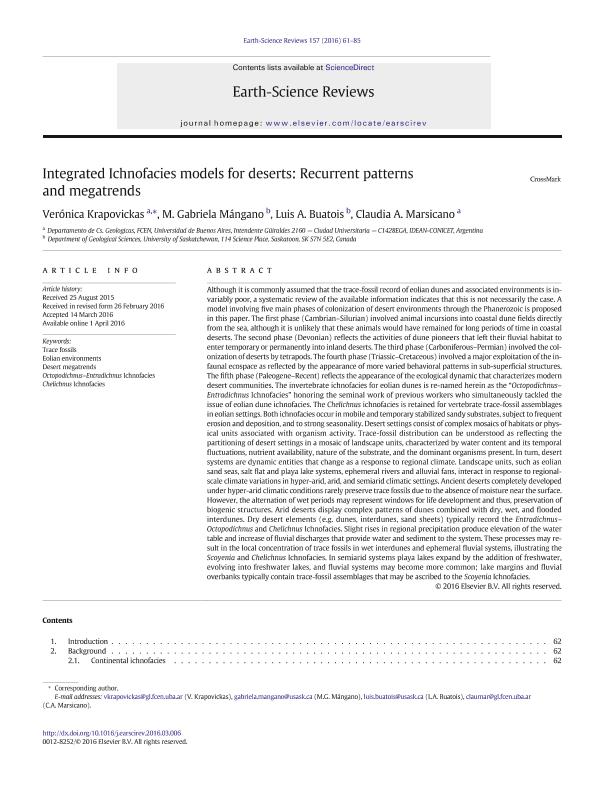Mostrar el registro sencillo del ítem
dc.contributor.author
Krapovickas, Verónica

dc.contributor.author
Mangano, Maria Gabriela

dc.contributor.author
Buatois, Luis Alberto

dc.contributor.author
Marsicano, Claudia Alicia

dc.date.available
2019-10-02T20:15:34Z
dc.date.issued
2016-06
dc.identifier.citation
Krapovickas, Verónica; Mangano, Maria Gabriela; Buatois, Luis Alberto; Marsicano, Claudia Alicia; Integrated Ichnofacies models for deserts: Recurrent patterns and megatrends; Elsevier Science; Earth-science Reviews; 157; 6-2016; 61-85
dc.identifier.issn
0012-8252
dc.identifier.uri
http://hdl.handle.net/11336/85054
dc.description.abstract
Although it is commonly assumed that the trace-fossil record of eolian dunes and associated environments is invariably poor, a systematic review of the available information indicates that this is not necessarily the case. A model involving five main phases of colonization of desert environments through the Phanerozoic is proposed in this paper. The first phase (Cambrian-Silurian) involved animal incursions into coastal dune fields directly from the sea, although it is unlikely that these animals would have remained for long periods of time in coastal deserts. The second phase (Devonian) reflects the activities of dune pioneers that left their fluvial habitat to enter temporary or permanently into inland deserts. The third phase (Carboniferous-Permian) involved the colonization of deserts by tetrapods. The fourth phase (Triassic-Cretaceous) involved a major exploitation of the infaunal ecospace as reflected by the appearance of more varied behavioral patterns in sub-superficial structures. The fifth phase (Paleogene-Recent) reflects the appearance of the ecological dynamic that characterizes modern desert communities. The invertebrate ichnofacies for eolian dunes is re-named herein as the "Octopodichnus-Entradichnus Ichnofacies" honoring the seminal work of previous workers who simultaneously tackled the issue of eolian dune ichnofacies. The Chelichnus ichnofacies is retained for vertebrate trace-fossil assemblages in eolian settings. Both ichnofacies occur in mobile and temporary stabilized sandy substrates, subject to frequent erosion and deposition, and to strong seasonality. Desert settings consist of complex mosaics of habitats or physical units associated with organism activity. Trace-fossil distribution can be understood as reflecting the partitioning of desert settings in a mosaic of landscape units, characterized by water content and its temporal fluctuations, nutrient availability, nature of the substrate, and the dominant organisms present. In turn, desert systems are dynamic entities that change as a response to regional climate. Landscape units, such as eolian sand seas, salt flat and playa lake systems, ephemeral rivers and alluvial fans, interact in response to regional-scale climate variations in hyper-arid, arid, and semiarid climatic settings. Ancient deserts completely developed under hyper-arid climatic conditions rarely preserve trace fossils due to the absence of moisture near the surface. However, the alternation of wet periods may represent windows for life development and thus, preservation of biogenic structures. Arid deserts display complex patterns of dunes combined with dry, wet, and flooded interdunes. Dry desert elements (e.g. dunes, interdunes, sand sheets) typically record the Entradichnus-Octopodichnus and Chelichnus Ichnofacies. Slight rises in regional precipitation produce elevation of the water table and increase of fluvial discharges that provide water and sediment to the system. These processes may result in the local concentration of trace fossils in wet interdunes and ephemeral fluvial systems, illustrating the Scoyenia and Chelichnus Ichnofacies. In semiarid systems playa lakes expand by the addition of freshwater, evolving into freshwater lakes, and fluvial systems may become more common; lake margins and fluvial overbanks typically contain trace-fossil assemblages that may be ascribed to the Scoyenia Ichnofacies.
dc.format
application/pdf
dc.language.iso
eng
dc.publisher
Elsevier Science

dc.rights
info:eu-repo/semantics/openAccess
dc.rights.uri
https://creativecommons.org/licenses/by-nc-sa/2.5/ar/
dc.subject
CHELICHNUS ICHNOFACIES
dc.subject
DESERT MEGATRENDS
dc.subject
EOLIAN ENVIRONMENTS
dc.subject
OCTOPODICHNUS-ENTRADICHNUS ICHNOFACIES
dc.subject
TRACE FOSSILS
dc.subject.classification
Otras Ciencias de la Tierra y relacionadas con el Medio Ambiente

dc.subject.classification
Ciencias de la Tierra y relacionadas con el Medio Ambiente

dc.subject.classification
CIENCIAS NATURALES Y EXACTAS

dc.title
Integrated Ichnofacies models for deserts: Recurrent patterns and megatrends
dc.type
info:eu-repo/semantics/article
dc.type
info:ar-repo/semantics/artículo
dc.type
info:eu-repo/semantics/publishedVersion
dc.date.updated
2019-09-20T13:43:21Z
dc.journal.volume
157
dc.journal.pagination
61-85
dc.journal.pais
Países Bajos

dc.journal.ciudad
Amsterdam
dc.description.fil
Fil: Krapovickas, Verónica. Consejo Nacional de Investigaciones Científicas y Técnicas. Oficina de Coordinación Administrativa Ciudad Universitaria. Instituto de Estudios Andinos "Don Pablo Groeber". Universidad de Buenos Aires. Facultad de Ciencias Exactas y Naturales. Instituto de Estudios Andinos "Don Pablo Groeber"; Argentina
dc.description.fil
Fil: Mangano, Maria Gabriela. University of Saskatchewan; Canadá
dc.description.fil
Fil: Buatois, Luis Alberto. University of Saskatchewan; Canadá
dc.description.fil
Fil: Marsicano, Claudia Alicia. Consejo Nacional de Investigaciones Científicas y Técnicas. Oficina de Coordinación Administrativa Ciudad Universitaria. Instituto de Estudios Andinos "Don Pablo Groeber". Universidad de Buenos Aires. Facultad de Ciencias Exactas y Naturales. Instituto de Estudios Andinos "Don Pablo Groeber"; Argentina
dc.journal.title
Earth-science Reviews

dc.relation.alternativeid
info:eu-repo/semantics/altIdentifier/doi/http://dx.doi.org/10.1016/j.earscirev.2016.03.006
dc.relation.alternativeid
info:eu-repo/semantics/altIdentifier/url/https://www.sciencedirect.com/science/article/pii/S0012825216300514
Archivos asociados
